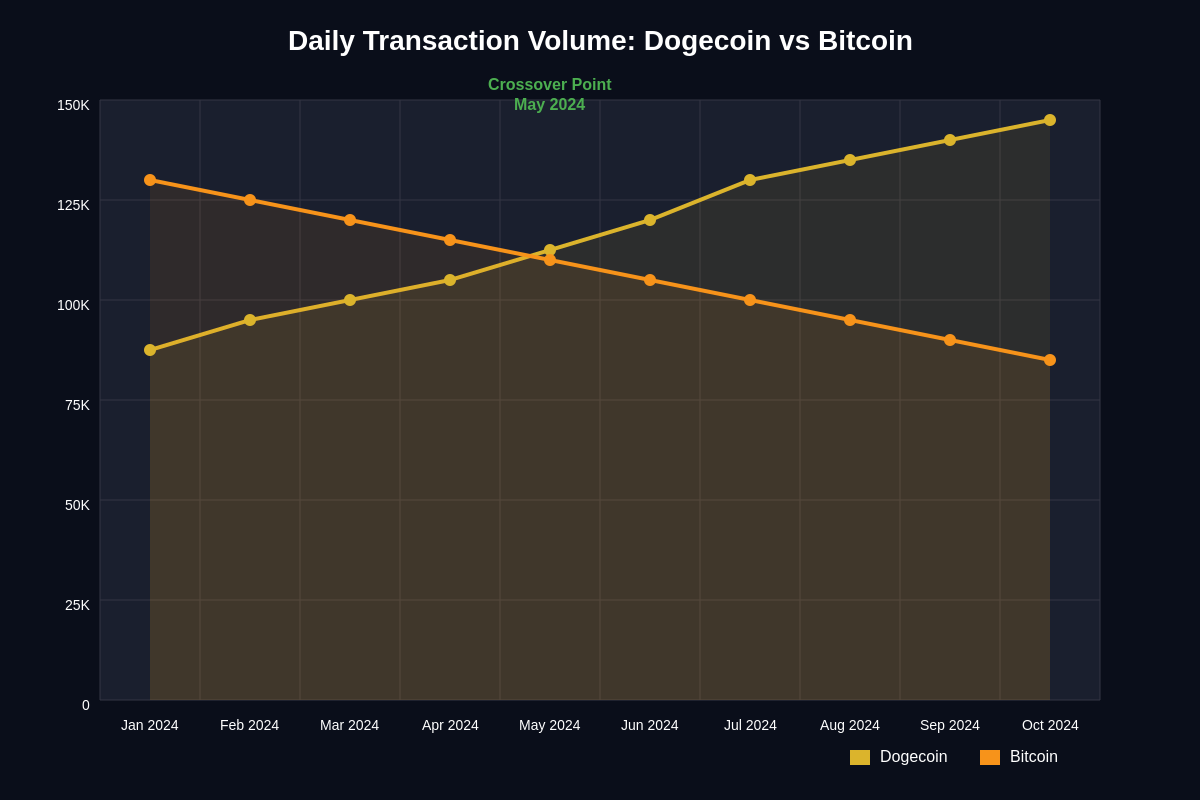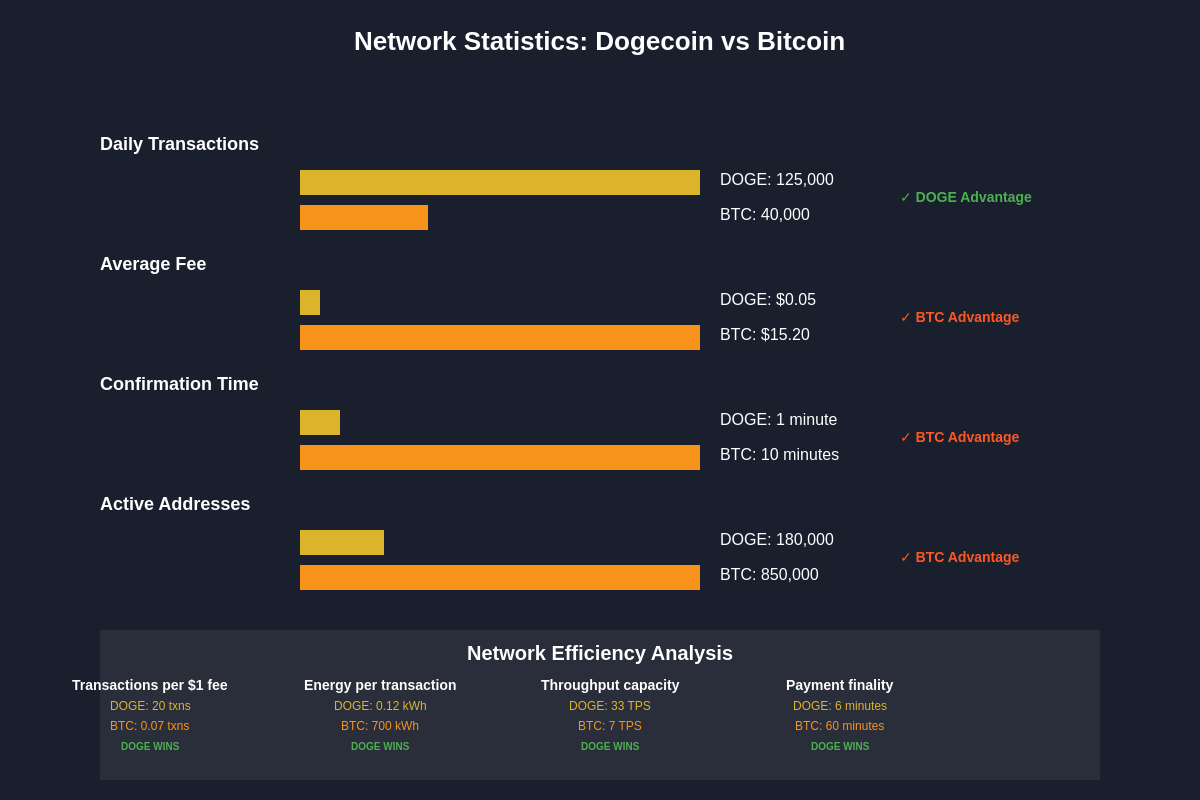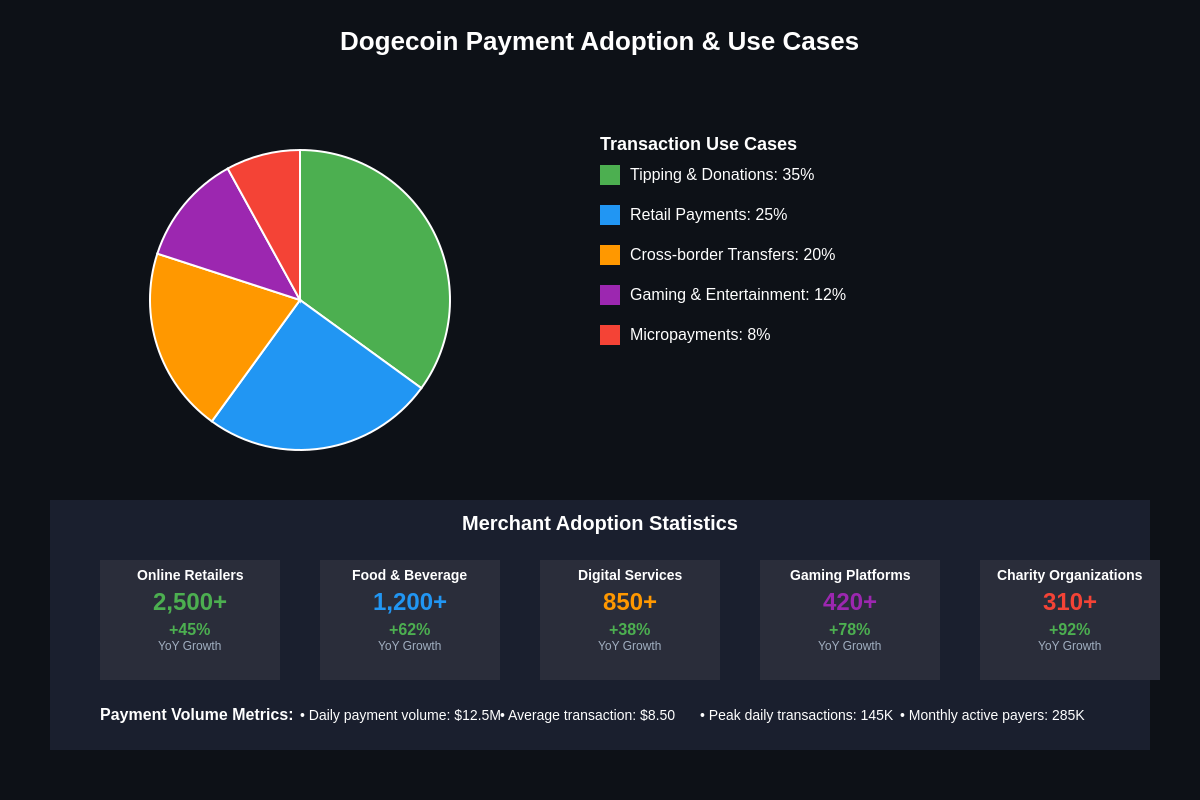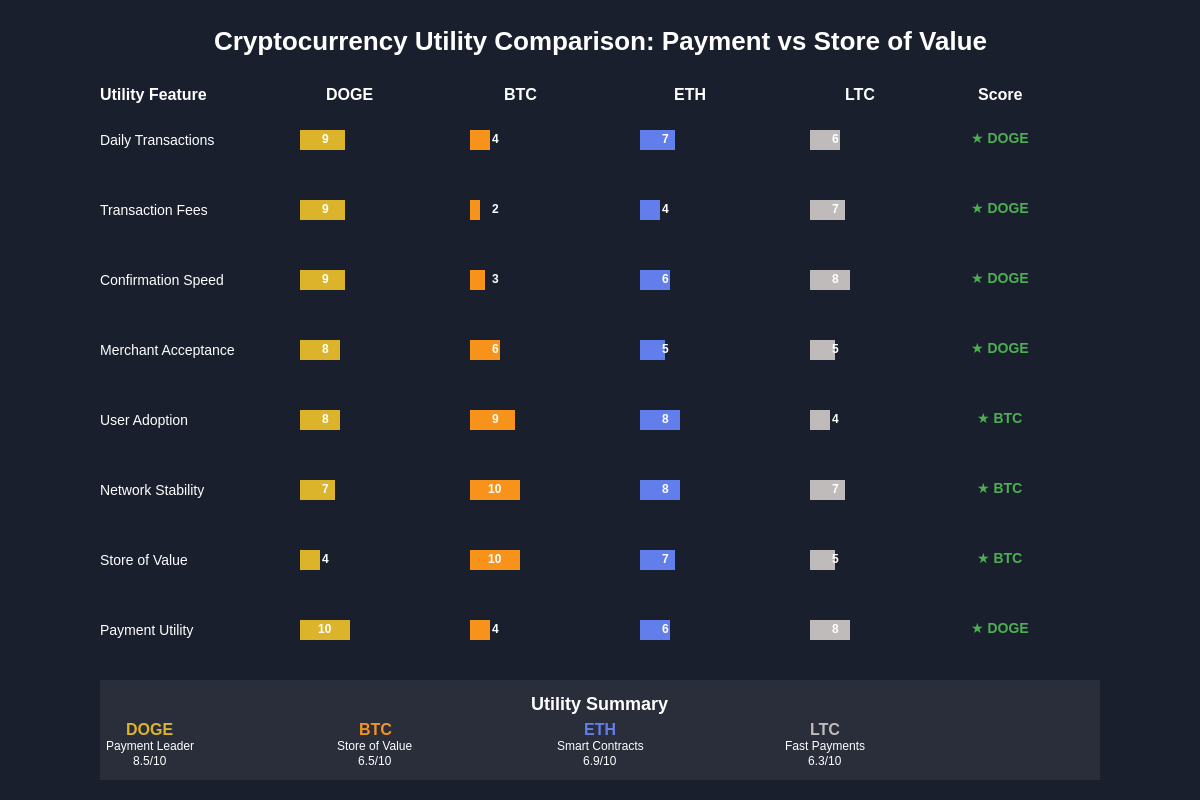The Shocking Reality of Network Activity
Dogecoin’s transaction volume has achieved a remarkable milestone by surpassing Bitcoin’s daily transaction count, marking a pivotal moment in cryptocurrency history that challenges conventional assumptions about network value, utility, and adoption patterns. This unprecedented development demonstrates how a cryptocurrency originally created as a joke has evolved into one of the most actively used digital payment networks, processing more individual transactions than the world’s largest cryptocurrency by market capitalization.

Track Dogecoin’s real-time transaction data and network statistics using comprehensive blockchain analytics and monitoring tools to understand the magnitude of this achievement.
The significance of Dogecoin’s transaction volume milestone extends far beyond simple metrics, representing a fundamental shift in how cryptocurrency networks achieve practical utility and real-world adoption. While Bitcoin has traditionally dominated discussions about cryptocurrency value and investment potential, Dogecoin’s transaction leadership highlights the importance of usability, accessibility, and community engagement in driving actual blockchain usage rather than mere speculative trading activity.
This development forces a reconsideration of what constitutes success in cryptocurrency networks, suggesting that transaction volume and practical utility may be more important indicators of long-term viability than market capitalization or institutional investment interest. The implications of this shift extend throughout the cryptocurrency ecosystem, influencing how developers, investors, and users evaluate the relative merits of different blockchain networks and their potential for mainstream adoption.
Understanding the Transaction Volume Metrics
The measurement of transaction volume in cryptocurrency networks involves complex considerations beyond simple transaction counts, including average transaction size, network throughput, and the practical purposes behind different types of blockchain activity. Dogecoin’s superior transaction volume reflects both its lower transaction fees and its community’s preference for using the cryptocurrency for actual payments rather than long-term investment holding strategies.
Bitcoin’s transaction patterns reveal a network increasingly optimized for high-value transfers and store-of-value functions, with users treating Bitcoin as digital gold rather than a medium of exchange for everyday transactions. The average Bitcoin transaction value significantly exceeds Dogecoin transactions, reflecting its role as a settlement layer for large financial movements rather than a payment system for routine commercial activity.
Dogecoin’s transaction characteristics demonstrate the network’s evolution into a practical payment system, with users regularly conducting smaller-value transactions for tips, donations, charitable giving, and everyday purchases. Monitor comparative transaction patterns across major cryptocurrencies to understand how different networks serve distinct use cases and user communities.
The technical implications of higher transaction volume extend to network security, decentralization, and sustainability considerations, as increased usage provides greater fee revenue for miners while also testing the limits of blockchain scalability and processing capacity. Understanding these dynamics becomes crucial for evaluating the long-term viability and success metrics of different cryptocurrency networks.
Historical Context and Evolution
Dogecoin’s journey from internet meme to high-volume transaction network represents one of the most unexpected success stories in cryptocurrency history, demonstrating how community engagement and practical utility can drive adoption more effectively than sophisticated technology or institutional marketing campaigns. The network’s evolution reflects broader trends in cryptocurrency adoption, where usability and cultural resonance often prove more important than technical sophistication.
The early development of Dogecoin prioritized accessibility and user-friendliness over technical innovation, creating a network that remained approachable for newcomers while avoiding the complexity and intimidation factors that characterize many cryptocurrency projects. This design philosophy contributed to sustainable community growth and practical adoption patterns that eventually manifested in superior transaction volume metrics.
Bitcoin’s transaction evolution followed a different trajectory, with increasing adoption by institutional investors and high-net-worth individuals driving up average transaction values while reducing the frequency of smaller, everyday transactions. The development of the Lightning Network and other layer-two solutions reflected Bitcoin’s community’s recognition that the base layer had become unsuitable for microtransactions and routine payments.
Comparative analysis of transaction patterns over time reveals how different cryptocurrency communities develop distinct usage cultures and practical applications, with these cultural factors ultimately influencing network activity levels and adoption patterns. The success of Dogecoin’s transaction volume growth demonstrates the importance of community culture in driving cryptocurrency utility and adoption.
Technical Infrastructure and Network Capabilities
Dogecoin’s technical architecture incorporates design decisions that prioritize transaction throughput and low fees over advanced functionality, creating a network optimized for high-volume, low-value transactions that characterize everyday payment activity. The network’s one-minute block time and relatively simple transaction structure enable rapid confirmation and processing of payments without the complexity overhead that characterizes more feature-rich blockchain platforms.

The mining infrastructure supporting Dogecoin benefits from merge mining with Litecoin, providing security and stability while maintaining the network’s ability to process large transaction volumes efficiently. This merged mining arrangement ensures adequate network security without requiring independent mining infrastructure that might limit scalability or increase transaction costs.
Fee structures on the Dogecoin network remain consistently low compared to Bitcoin, making microtransactions and small-value payments economically viable for users who would be deterred by higher transaction costs on other networks. These low fees contribute directly to higher transaction volume by removing economic barriers that prevent casual usage and small-value transfers.
Network scalability considerations for Dogecoin focus on maintaining transaction processing capacity while preserving the decentralization and accessibility characteristics that enable high-volume usage patterns. The technical simplicity of Dogecoin’s architecture provides advantages in scaling transaction volume while avoiding the complexity challenges that limit throughput on more sophisticated blockchain platforms.
Community Culture and Payment Adoption
The Dogecoin community’s culture of generosity, tipping, and charitable giving has created organic demand for transaction volume that extends beyond speculative trading into genuine utility and value transfer. This cultural foundation distinguishes Dogecoin from investment-focused cryptocurrencies, generating sustained transaction activity driven by community engagement rather than market speculation.
Social media platforms and online communities have embraced Dogecoin as a preferred medium for content creator tips, community rewards, and peer-to-peer value transfer, creating consistent demand for transaction volume that remains relatively independent of market price movements. This usage pattern provides stability and predictability in network activity that enhances Dogecoin’s utility value proposition.
Merchant adoption of Dogecoin for payment processing has grown organically through community advocacy and user demand, with businesses recognizing the practical advantages of accepting a cryptocurrency that users actually spend rather than hoard for investment purposes. This merchant adoption creates additional transaction volume while demonstrating real-world utility that justifies continued network development and support.
The psychological factors influencing Dogecoin usage include lower perceived value barriers that encourage spending rather than hoarding, combined with community norms that celebrate generosity and practical usage over investment speculation. These cultural elements contribute to sustained transaction volume growth that reflects genuine network utility rather than speculative trading activity.
Economic Implications of High Transaction Volume
The economic significance of Dogecoin’s transaction volume leadership extends beyond simple network metrics to fundamental questions about cryptocurrency value, utility, and long-term sustainability in competitive digital asset markets. High transaction volume indicates genuine user demand and practical adoption, providing economic validation for the network’s value proposition that extends beyond speculative market interest.
Revenue generation for network miners and validators benefits from higher transaction volume through increased fee collection, even when individual transaction fees remain low compared to other networks. This fee revenue stream provides economic incentives for continued network maintenance and security while demonstrating sustainable economic models for blockchain operations.
The velocity of money within the Dogecoin network reflects active circulation and usage patterns that distinguish it from store-of-value cryptocurrencies where tokens remain relatively static in investor wallets. Higher velocity indicates healthy network economics and genuine utility, contributing to long-term network sustainability and growth potential.
Market perception of transaction volume metrics has begun incorporating Dogecoin’s leadership into valuation models and adoption forecasts, recognizing that practical usage provides more reliable indicators of long-term success than speculative trading activity. Analyze the relationship between transaction volume and price performance across different cryptocurrency networks to understand market dynamics and value creation patterns.
Comparative Analysis with Bitcoin Network
Bitcoin’s network optimization for high-value transactions and store-of-value functionality reflects deliberate design choices and community preferences that prioritize security and scarcity over transaction throughput and everyday usability. These optimization decisions create natural trade-offs that explain why Bitcoin processes fewer individual transactions despite maintaining larger aggregate transaction value and market capitalization.
The average transaction value differential between Bitcoin and Dogecoin illustrates how different cryptocurrencies serve distinct market segments and use cases, with Bitcoin functioning as a settlement layer for significant financial transfers while Dogecoin operates as a payment network for routine value exchange. Understanding these functional differences helps explain why transaction volume leadership may be more important for payment-focused networks.
Layer-two solutions and scaling developments on Bitcoin aim to address transaction volume limitations while preserving the base layer’s security and decentralization characteristics, though adoption of these solutions remains limited compared to the direct transaction volume achieved by Dogecoin’s base layer. The complexity of layer-two implementations creates barriers to adoption that maintain Dogecoin’s advantages in transaction volume metrics.
Network effect dynamics favor cryptocurrencies that achieve high transaction volume through direct usability advantages, as practical adoption creates self-reinforcing cycles of merchant acceptance, user growth, and continued transaction volume increases. Dogecoin’s transaction volume leadership positions it advantageously within these network effect dynamics compared to cryptocurrencies that prioritize other characteristics over transaction throughput.
Merchant Adoption and Payment Processing
The practical advantages of Dogecoin for merchant payment processing include lower transaction fees, faster confirmation times, and higher probability that customers will actually spend their holdings rather than treating them as long-term investments. These factors combine to create compelling economic incentives for businesses to accept Dogecoin payments, contributing to sustained transaction volume growth through commercial adoption.

Payment processing infrastructure for Dogecoin has evolved to support merchant needs through simplified integration tools, reliable transaction confirmation, and competitive fee structures that enable profitability for businesses accepting cryptocurrency payments. The maturation of this infrastructure facilitates broader commercial adoption while reducing technical barriers that might limit transaction volume growth.
Consumer behavior patterns in Dogecoin spending reflect the currency’s cultural positioning as a medium of exchange rather than an investment vehicle, leading to higher propensity to spend holdings on goods and services rather than holding for appreciation. This spending propensity directly translates into higher transaction volume and commercial activity that benefits merchants and the broader network ecosystem.
Cross-border payment applications represent a significant opportunity for Dogecoin’s transaction volume growth, as international transfers benefit from the network’s low fees and rapid processing times compared to traditional financial infrastructure. The global nature of cryptocurrency networks allows Dogecoin to capture transaction volume from international commerce and remittance markets.
Technological Advantages and Limitations
Dogecoin’s technological simplicity provides both advantages and limitations in achieving high transaction volume, with streamlined architecture enabling efficient processing while limiting advanced functionality that might attract different types of network usage. Understanding these trade-offs helps explain why Dogecoin excels in transaction volume metrics while other networks focus on different technical capabilities.
Block time optimization in Dogecoin’s network enables rapid transaction confirmation that improves user experience and merchant confidence in payment processing, contributing to higher adoption rates and transaction volume compared to networks with longer confirmation times. The one-minute block time provides practical advantages for everyday payment scenarios while maintaining network security.
Scalability considerations for maintaining high transaction volume include network capacity limits, mining incentive structures, and decentralization requirements that must be balanced to preserve the characteristics that enable Dogecoin’s transaction volume leadership. Future technical developments must address these considerations while maintaining the network’s practical advantages.
Integration capabilities with existing payment infrastructure and financial systems benefit from Dogecoin’s technical simplicity and mature codebase, enabling easier adoption by payment processors and merchant services compared to more complex blockchain platforms. This integration advantage supports continued transaction volume growth through expanded commercial acceptance.
Regulatory Environment and Compliance
Regulatory treatment of high-transaction-volume cryptocurrencies like Dogecoin involves considerations around payment system regulation, anti-money laundering compliance, and consumer protection requirements that differ from regulations governing investment-focused digital assets. Understanding these regulatory dynamics becomes crucial as transaction volume growth attracts increased regulatory attention and potential oversight requirements.
Payment system regulations may apply differently to cryptocurrencies that achieve significant transaction volume for commercial purposes, potentially requiring compliance with financial services regulations that govern traditional payment networks. The evolving regulatory landscape creates both opportunities and challenges for maintaining transaction volume growth while meeting compliance obligations.
Tax implications for users of high-transaction-volume cryptocurrencies include reporting requirements for payment transactions, merchant sales obligations, and record-keeping challenges associated with frequent cryptocurrency usage. These compliance considerations may influence user behavior and transaction patterns as regulatory frameworks mature.
International regulatory coordination becomes increasingly important as cryptocurrency networks achieve global transaction volume that crosses multiple jurisdictions and regulatory frameworks. Dogecoin’s international usage patterns require navigation of diverse regulatory environments while maintaining the network characteristics that enable high transaction volume.
Market Impact and Investment Implications
Investment analysis frameworks for cryptocurrencies are evolving to incorporate transaction volume metrics as indicators of fundamental value and long-term sustainability, recognizing that practical adoption provides more reliable value support than speculative trading activity. Dogecoin’s transaction volume leadership challenges traditional market capitalization-focused valuation approaches.
Portfolio diversification strategies increasingly consider transaction volume characteristics when allocating among different cryptocurrencies, with high-volume networks offering exposure to payment adoption trends while low-volume, high-value networks provide store-of-value characteristics. Understanding these functional differences enables more sophisticated cryptocurrency portfolio construction.
Institutional investment perspectives on transaction volume metrics vary depending on investment objectives, with some institutions prioritizing networks that demonstrate practical adoption while others focus on store-of-value characteristics or technological innovation. Dogecoin’s transaction volume leadership appeals to institutions seeking exposure to cryptocurrency payment adoption trends.
Market efficiency considerations suggest that transaction volume provides more accurate signals about cryptocurrency utility and adoption than price movements driven by speculation, potentially making transaction volume-based investment strategies more sustainable than approaches focused purely on price appreciation. Monitor transaction volume trends across cryptocurrency markets to identify emerging adoption patterns and investment opportunities.

Future Implications and Network Evolution
The long-term sustainability of Dogecoin’s transaction volume leadership depends on continued community engagement, technological development, and competitive positioning relative to other payment-focused cryptocurrencies and traditional financial infrastructure. Maintaining transaction volume advantages requires ongoing attention to user experience, cost efficiency, and merchant adoption support.
Potential challenges to transaction volume growth include network capacity limits, regulatory restrictions, and competition from other payment systems that may offer superior characteristics for specific use cases. Anticipating and addressing these challenges becomes crucial for maintaining Dogecoin’s position as a transaction volume leader in evolving cryptocurrency markets.
Technological development priorities for transaction volume-focused networks include scalability improvements, user experience enhancements, and integration capabilities that support continued adoption growth. Balancing these development priorities with maintaining existing network advantages requires careful planning and community coordination.
The broader implications of transaction volume leadership for cryptocurrency industry development include demonstration effects for other networks, validation of payment-focused use cases, and potential influence on regulatory approaches to cryptocurrency classification and oversight. Dogecoin’s success in achieving high transaction volume provides lessons for other cryptocurrency projects seeking practical adoption.
Global Adoption Patterns and Usage Trends
International adoption patterns for Dogecoin reflect the network’s advantages in cross-border payments, particularly in regions where traditional financial infrastructure limitations create demand for alternative payment systems. Geographic analysis of transaction volume reveals how cryptocurrency adoption varies based on local economic conditions, regulatory environments, and technological infrastructure.
Demographic trends in Dogecoin usage show particular strength among younger users and technology-early adopters who are comfortable with cryptocurrency payments and attracted to the network’s cultural characteristics. Understanding these demographic patterns helps predict future adoption trends and identify growth opportunities for transaction volume expansion.
Economic development applications for high-transaction-volume cryptocurrencies include financial inclusion initiatives, small business payment solutions, and international commerce facilitation that benefit from cryptocurrency networks’ global accessibility and low transaction costs. These applications create sustainable demand for transaction volume that supports long-term network growth.
Cultural factors influencing cryptocurrency adoption vary significantly across different markets and communities, with Dogecoin’s internet culture origins creating particular resonance in digitally-connected global communities while potentially limiting adoption in more traditional or culturally conservative markets. Balancing cultural appeal with broad accessibility remains crucial for maximizing transaction volume growth.
Technical Innovation and Development Roadmap
Future development priorities for maintaining transaction volume leadership include user experience improvements, merchant integration tools, and scalability enhancements that support continued growth while preserving the network characteristics that enable high transaction volume. Development roadmaps must balance innovation with maintaining existing advantages.
Integration opportunities with emerging financial technologies include central bank digital currencies, decentralized finance protocols, and next-generation payment systems that could expand Dogecoin’s utility and transaction volume through enhanced interoperability and functionality. Strategic integration planning becomes crucial for maintaining competitive positioning.
Security enhancements and network resilience improvements ensure that high transaction volume can be maintained safely and reliably as the network grows and attracts increased attention from both users and potential attackers. Balancing security with usability and performance remains an ongoing challenge for high-volume cryptocurrency networks.
Open-source development community engagement provides the foundation for continued technical innovation and improvement, with community-driven development ensuring that improvements align with user needs and network utility objectives rather than purely technological advancement for its own sake.
Conclusion and Strategic Implications
Dogecoin’s achievement in surpassing Bitcoin’s transaction volume represents a paradigm shift in cryptocurrency success metrics, demonstrating that practical utility and community engagement can drive network adoption more effectively than market capitalization or institutional investment interest. This development challenges conventional assumptions about cryptocurrency value and provides new frameworks for evaluating network success and long-term viability.
The strategic implications of transaction volume leadership extend throughout the cryptocurrency ecosystem, influencing development priorities, investment strategies, and regulatory approaches to digital asset classification and oversight. Understanding these implications becomes crucial for all participants in cryptocurrency markets, from individual users to institutional investors and regulatory authorities.
The lessons learned from Dogecoin’s transaction volume success provide valuable insights for other cryptocurrency projects seeking practical adoption, highlighting the importance of community culture, usability optimization, and sustainable economic models in achieving genuine network utility. These lessons have broad applicability beyond meme-based cryptocurrencies to the entire digital asset ecosystem.
Stay informed about transaction volume trends and network adoption metrics to understand evolving cryptocurrency market dynamics and identify emerging opportunities in payment-focused digital assets.
As the cryptocurrency industry continues maturing, transaction volume metrics will likely gain increased recognition as fundamental indicators of network health, adoption success, and long-term sustainability. Dogecoin’s leadership in these metrics positions it as an important case study for understanding how cryptocurrencies can achieve practical utility and genuine economic value through community engagement and user-focused development.
Disclaimer: This article is for informational purposes only and does not constitute financial advice. Cryptocurrency investments involve significant risks, including potential total loss of invested capital. Past performance does not guarantee future results. Always conduct thorough research and consider your risk tolerance before making investment decisions. Transaction volume metrics do not guarantee future price performance or investment returns.